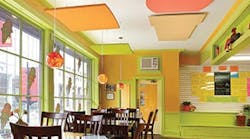As more designers incorporate open floor plans and exposed ceilings into buildings, acoustical comfort has often suffered. Speech is either garbled or invasive, occupants are unhappy, and productivity declines.
Suspend acoustical clouds and canopies from ceilings in these areas and lift your occupants to cloud nine.
Select the Right Material for the
Application
The first thing to do is identify the nature of your problem, because it will impact which solution you need.
“What clouds and canopies do best is either absorb or diffuse noise,” says Ethan C. Salter, acoustical consultant at Charles M. Salter Associates, Inc. “That depends on the materials used and how they’re employed.”
Determine whether you’re trying to achieve speech privacy or speech intelligibility.
“Absorptive clouds and canopies are used to control noise in an office, atrium, lab, or any large, open space. They work in basically the same areas we’d use acoustic ceiling tiles,” explains Gregory A. Coudriet, acoustical consultant for The Sextant Group, Inc.
Absorptive materials improve speech privacy by intercepting it before it can bounce off pipes, ductwork, and exposed decks, extending reverberation time. They include fiberglass, mineral board, and even cotton.
Fiberglass is the preferred choice for speech privacy, Salter adds, because its porous nature is more effective at absorption.
“Anywhere that requires speech intelligibility – like a lecture, conference, or concert hall – that’s where we use diffusive and reflective materials,” Coudriet adds. “Solving those problems gets technical and requires an expert, but most commercial buildings simply require speech privacy. It’s important to make the distinction.”
If you’re aiming to improve intelligibility, be careful not to employ an absorptive material.
How to Specify a Solution
After deciding on the correct material, determining how much of it you’ll need is the next battle. The first criterion you’ll encounter is the noise reduction coefficient (NRC).
“The NRC rating is a number indicator of how absorptive a material is, and it’s also expressed as a percentage. If something has a rating of 0.75, it will absorb 75% of the sound,” explains Coudriet. “Typical acoustical ceiling tiles range from 0.5-0.95, and you’ll find the same applies to clouds and canopies.”
Specifying clouds and canopies hinges on a specialized performance metric called sabins.
“If you were to multiply the NRC rating by the square footage of the ceiling, you would come up with sabins,” Coudriet says.
Achieving the required level of sabins depends on the material’s NRC rating, and subsequently, how much of that material you’d need. Most clouds and canopies tend to have a high NRC rating, Coudriet says, and thus fewer of them – compared to ceiling tiles – are needed to achieve acoustical comfort.
“If you have a sea of cubicles, we typically recommend a cloud over every pack of cubes, depending on size,” Salter advises. “Rather than one, monolithic, lay-in tile ceiling, you can put the sound absorptive treatments right where the people are.”
Environmentally and Aesthetically
Pleasing
Material reduction is an element of eco-friendliness, but acoustical clouds and canopies have another sustainability story. “LEED is adapting and evolving to address acoustical complaints,” says Salter. “Manufacturers are getting greener.”
The fabric, vinyl, and fiberglass used in these treatments can be manufactured with recycled content and without toxic binders, explains Coudriet, adding that Armstrong and Hunter Douglas have made strides in sustainability.
Selecting the right product based on your performance and sustainability requirements may sound like a difficult enough endeavor, and arriving at an aesthetically pleasing choice won’t be any easier.
Clouds and canopies are available in convex or concave squares, circles, waves, or curves. “They can be very seamless and monolithic, almost like ceiling tiles, or very eye-catching, almost like a sculpture,” says Salter. “I’ve seen architects get pretty creative.”
Cost will also impact your decision, and that varies widely – from $20-50 per square foot, depending on the design you choose, Salter notes.
“This type of design can be a reasonable solution depending on your space,” he adds. “A cloud is fun to look at, and with its absorptive properties, it’s really doing double duty.”
Chris Curtland [email protected] is assistant editor of BUILDINGS.


